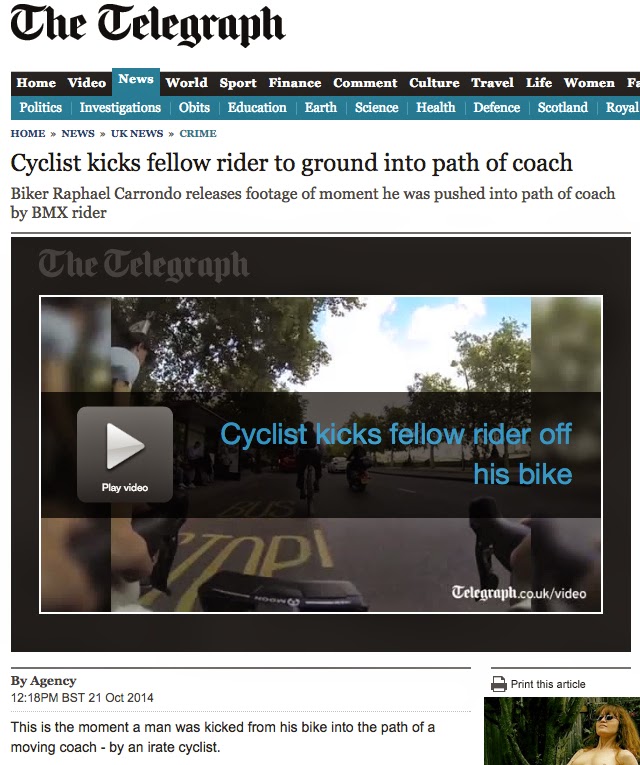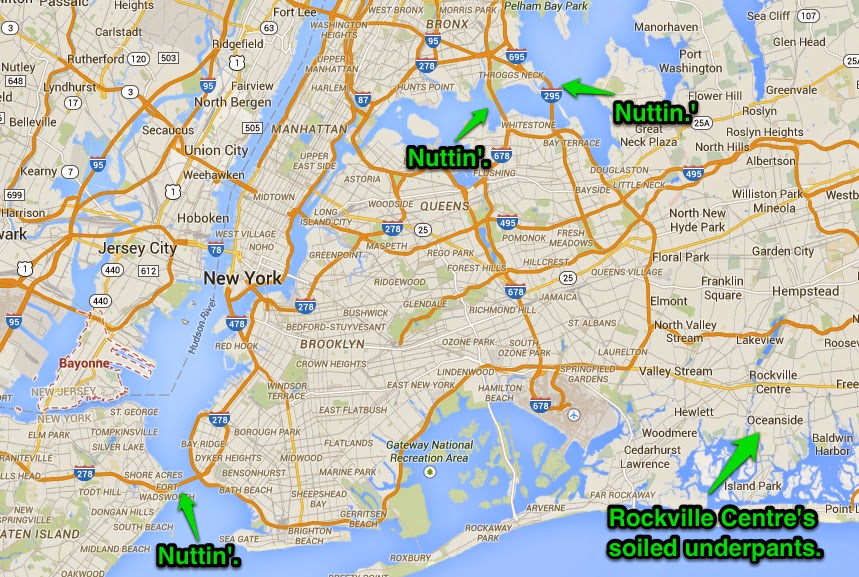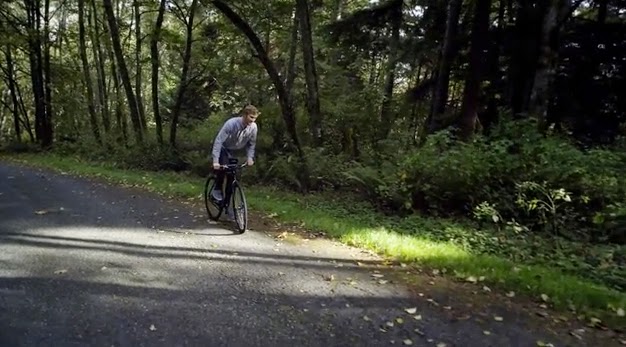Raphael Carrondo was pushed into the side of the vehicle by a BMX rider.
Just moments before, the 32-year-old was forced to slam on his brakes as the unknown rider tried undertaking him as the pair were passing a parked bus.
Then, about 100 yards up the road as Raphael was overtaking a coach just as it began pulling out, the cyclist rode past his right side and kicked his front wheel.
Here is the very moment at which the rogue BMXer launched his lifestyle sneaker at the cyclist:
The assailant remains at large, though police suspect he was enraged by the victim's CamelBak:
The BMXer was last seen being a virgin and wearing a flat-brim cap and a "Red Bull Gives You Road Rage" t-shirt, so keep your eyes open for him.
In other news, yesterday I kvetched and bloviated about cycling in and around New York City--which, now that I think about it, is pretty much what I do every day. (Well that's depressing.) Specifically, I scoffed at "Bicycling" magazine's suggesting Oceanside as a cycling destination, mostly because Oceanside is so incredibly lame that even people in East Rockaway derisively refer to it as "Rockville Centre's soiled underpants."
Well, if bike advocates have their way, you'll be able to add a whole new list of questionable destinations to your New York City cycling bucket list, because a bike lane on the Verrazano Bridge would mean you'd finally be able to access exotic locales like Staten Island and (be still my heart, I can hardly even type the name without swooning) Bayonne:
The activists are campaigning for what they call the Harbor Ring, a roughly 50-mile route that circumnavigates the waterfronts of three boroughs and New Jersey. Starting in Staten Island, it crosses the Bayonne Bridge, heads up the New Jersey Gold Coast to Weehawken, onto a ferry to West 39th Street in Manhattan, down the Hudson River Greenway and the Battery, over the Manhattan Bridge, and finishes on the waterfront in Brooklyn from Red Hook to Bay Ridge.
With booming bike use on both sides of both rivers, the only missing link is the Verrazano.
All kidding aside, a bike lane on the Verrazano Bridge is long overdue, and if anything the utter lack of cycling facilities on three of New York City's mightiest suspension bridges (the Verrazano, the Whitestone, and the Throgs Neck) is yet another reason I scoff--scoff, I tell you!--at the idea that we're America's Number One Bike City:
This latest push for a bike lane on the Verrazano has received a fair amount of local media attention recently, and I strongly suggest you refrain from reading the comments on any of the articles about it, because they usually run along these lines:
--Morons insisting the cyclists should have to pay the same toll as the drivers because drivers pay for the roads (Staten Islanders are very resentful of tolls, because apparently they didn't realize they were moving onto an island until they tried to leave it);
--Morons saying they don't want bikes coming to Staten Island because then they'll get invaded by Brooklyn hipsters;
--Morons saying the bridge is "too windy" for bikes.
That last one's my favorite. Every time the Verrazano bike lane thing comes up someone weighs in and says the bridge is too windy, which is funny because the Five Boro Bike Tour goes across the bridge every year and I have no recollection of thousands of dorks in pinnies being blown off the bridge and swept out to sea:
Though if they did I suppose they'd be easy to find. Not only would they be highly visible in their pinnies, but they'd also be highly buoyant in their giant Bell helmets from 1989. (This is standard issue headgear for the typical Five Boro Bike Tour rider, and a medium-sized adult could use one as a dinghy without much difficulty.)
Speaking of the Five Boro Bike Tour, I was perusing Kickstarter when I stumbled upon the ideal charity ride slayer:
Or, if you prefer, the ultimate sidewalk-riding bike:
You know the story by now. Designer and engineer can't find a bike that meets his incredibly high standards, blah blah blah:
"Because as I looked around most commuter bicyclist are either riding converted mountain bikes or they're riding converted road bikes."
Really?
Well, as far as he's concerned the answer is yes, so he invented "the first carbon commuter bike on the market:"
Which is emphatically not the first crabon bike on the market, and he'd better be careful because Specialized is liable to sue him for making that claim:
Nevertheless, he maintains that his bike is "revolutionary:
"What's revolutionary about the Rogue is the bike itself weighs 20 and a half pounds, which is unheard of for a commuter bike."
This is emphatically not unheard of for a commuter bike--or for a flat bar "cyclecross" bike (or what we used to call a "hybrid" back in the '90s), which is basically what this is:
Also, it's made of you-know-what:
"It's made out of carbon. Carbon compared to alloys is approximately seven and a half times stronger, but is usually somewhere in the region of about 50 or 60 percent lighter."
Which alloys exactly? There are many. This is like saying "apples are approximately five times more delicious than melons."
But it's not just the crabon and the low weight that make this bike revolutionary. It's also got something else:
"Most bikes on the market right now are using a technology that's over 100 years old, which is a chain."
Yeah, you know what's coming. Come on, it's Rule #1 in the "Reinventing the Hybrid" handbook! Let's all say it at the same time:
("Carbon! Belt! Drive!")
Which is also the "same apparatus that's used on motorcycles and some of the heavier industry type vehicles like combine harvesters..."
Yeah, that's right. Combine harvesters:
That's exactly like a bicycle.
Also, the bicycle chain may be well over 100 years old, but technically so is the belt drive bicycle, which was first patented in 1890:
Instead of using sprocket-wheels upon the driving-axle and rear axle, as has heretofore been the almost universal custom in Safety bicycles, I use pulleys having V -shaped grooves upon both of said axles and transmit Fig. 4, 6251- 'iCO 1 edges-inclined toward each other to correspond with the V-shaped grooves in the driving and driven pulleys,the engagement of the belt with the pulleys being wholly with its edges.
I'm just saying, that's all.
And that's not all, either. Where would you be (literally) without GPS?
"The first GPS system is an application that you download on your phone. That basically gives you things like speed, cadence, elevation, and it shows you the map of your area so you can pretty much track your rides and you can share them with various people..."
So, basically, Strava.
And it's also got the theft-tracking device you've now come to expect from Kickstarter:
"The second part of the GPS is more for safety. So if you park your bike or lock it and it gets stolen, you can basically go back onto your phone, send your bike an SMS asking where it is, it'll send back location..."
In other words, you send a message to your bike:
And you get a reply:
Amazing.
Also the bike has built-in lights, yada yada yada, but most importantly it has Futuristic Space Fenders:
I like how the rear one provides 100% protection to the rider behind you, while simultaneously offering 0% protection to your own ass.

































